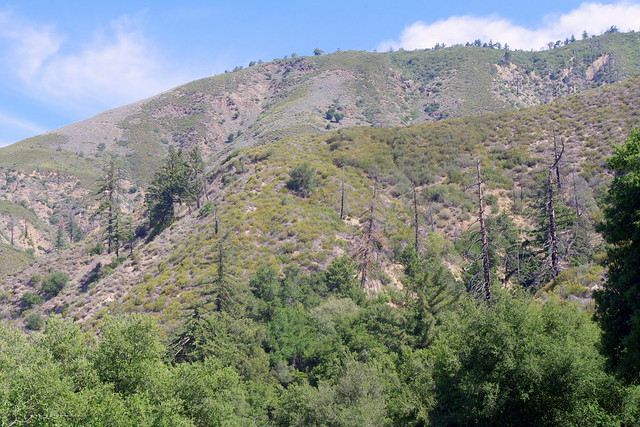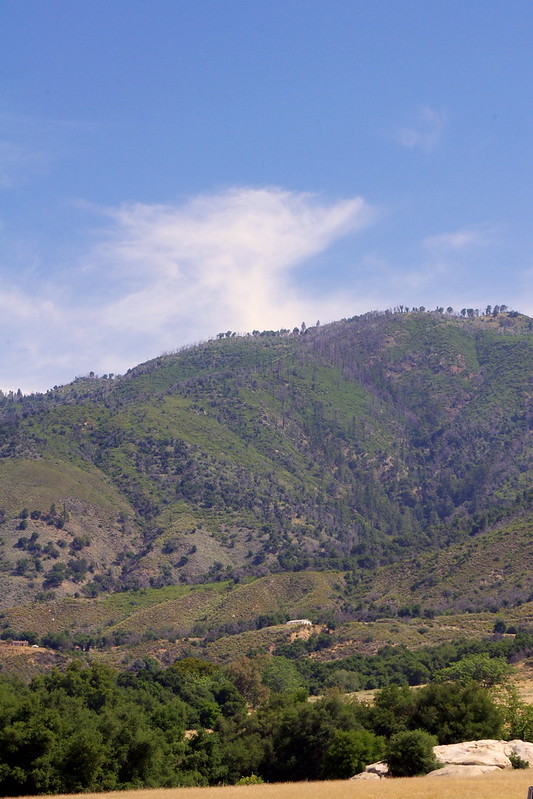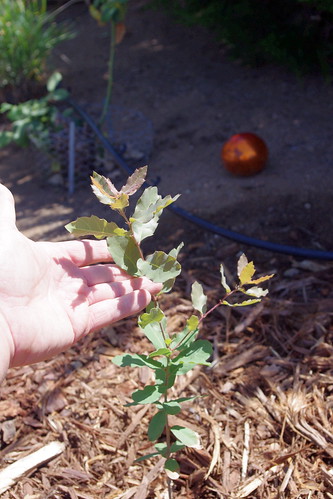 |
| NASA satellite photo (provided by NSPO, Taiwan National Space Organization) from October 23, 2007, showing the active fire zones and smoke plumes. |
 |
| Hairpin switchback on Hwy 76 at Palomar |
 |
| Courtesy Scott Turner, Escondido CA |
 |
| Photo: Mine |
Before dropping down and spiraling into the back and forth switchbacks, you'll see the western edges of the Palomar Mountains which I believe is the Agua Tibia Wilderness. The area was blitz heavily by this fire. I watched it all late night over here in Sweden as both the Witch Creek and Poomacha Fires did as they pleased. I read through the pages of the online San Diego Union where a concerned wildlife enthusiast hiked up Pauma Creek where remnants of the native Southern California Stealhead Trout were located and they were still some in tiny pools alive but just barely. The danger of course was the coming winter rainy season which would have filled these pools with tonnes of silt and other sediment and debris. He alerted what he thought were the correct officials to send teams in to rescue the trout before the disaster which was sure to happen. As is usual, it was insisted that certain studies would need to be performed followed by discussion. However, it did appear some made it but many many areas didn't and some pools disappeared under tonnes of debris. It will of course take years of winter rains and normal high water flows to scour out those pools once again, but of course there is that present decades drought problem. The story can be followed here on the San Diego Trout's own website. Very interesting read with many photos of before and after in the referenced links
http://www.sandiegotrout.org/archive.html
 |
| Photo: Mine |
This is yet another photo taken which is actually further east near the San Luis Rey River Campground. The dead trees are those of the tough Big Cone Douglas Fir trees which I always associate more with Chaparral than I do other forest trees, although they do mix with other large trees. They have the ability to survive and actually thrive on hot steep southern slope where no other tree can succeed. Well, other than Engelman Oak which has a survival strategy of being drought stress deciduous and partially sheds half it's leaves in desperate times if need be. Big Cone Doug fir will actually sprout from the truck and branches again, something the other native conifers are not capable of doing. Mountain Center California has prime examples of this sprouting after fire along Hwy 243 if you know where to look for them.
 |
| Photo: Mine |
This is the last open space of meadow just before you start dropping down into the steep switchback of the Pauma Grade on Hwy 76 where Pauma Valley and the Rincon Reservation / Casino which are are below. I wonder how many people have actually passed by here before and never truly appreciated the scenery before the fire took it away ?
 |
| Photo: Mine |
Now finally coming around that first turn to the left on the Hwy 76 switch back where you start to grasp the more open view of the hilltop and ridge terrain scenery and of course one this shot is from the first turnout location you come to. This view shows some trees still intact and making a recovery of sorts, but looking nothing like their former glory. You also can see where many did not survive the fire to make the survival journey at all as the dead snags clearly indicate. Still there is enough holdover evidence of the areas once dominant ecosystem of Engelman Oak woodlands.
 |
| Photo: Mine |
Same exact turnout as in the photo above this one, but the camera angle is further to the left looking directly across the other side of the road up the hill at the Engelman Oaks that survived. Notice the heavy cover of White Sage (Salvia apiana). This is common after fire. Fire to appear from my own observational view since the middle 1960s is that Deerweed (Lotus scoparius). Everyone should know that in many chaparral settings, especially nearer the inland valleys and coastal areas, these two shrubs are the first to comes back after fire wipes out the mature California Buckwheat / Sagebrush along with Laurel Sumac. In the old days after a fire tore through an area, the initial Springtime explosion of numerous varieties of wildflowers would be the first stage recovery component, followed by Deerweed which would blanket the hillsides for the first several years with White Sage moving in only to eventually overwhelm them. White Sage at the beginning will be huge, but will eventually yield to the California Buckwheat & Sagebrush. White Sage will always be present thereafter, but in a much smaller form. Laurel Sumac will sprout from the root crown immediately after the fire if moisture conditions are healthy in the sub-soils. It is these plant components which government agencies will almost always want to bypass, and clear the land by stripping it to the bare earth and immediately proceed to plant oak or other more desirable tree species if they were present in the location formerly. Especially is this true if the area were an officially designated Preserve or Park where the Public demands they do something quickly about restoration. Rather than actually educate the public as to the necessary role the early plants play in land revitalization as far as progression provides, they opt for a quick fix eye candy approach of replacing trees immediately with public approval. This is a shame because a healthier survival rate is produced and the earlier forage is better for the animal recovery. But always remember, these places are about pleasing people, not wildlife.
 |
| Photo: Mine |
This is the second turnout looking back up back across the Hwy 76 road again to the east. The lower areas where most of the one time picturesque Engelman Oak trees once existed were much harder hit by the raging Poomacha Fire. Most were gone and those that were trying to come back were struggling. Only a few single seemingly untouched looking specimens appeared as lone comebacks. Ones like this next picture below here.
 |
| Photo: Mine |
Same second turnout location, but this photo faces north towards the western edge of the Palomar Mountains which are in the background to the north. Around this particular tree were numerous wonderfully lush green examples of California Holly or Toyon as can be seen just behind the guard railing. You'll notice all the brown on the lower part of the shrub ? All over San Diego County on my road trip almost all vegetation was dead and brown from the ground up to a meter in height. This is San Diego County and CalTrans way of road maintenance of their roadway easements by means of chemical pesticides.
 |
| Photo Courtesy of OneOakGrowers |
I wish years ago more people had known about Engleman Oaks as far as landscape value. I wish I had done more with them. Tough little trees which need very little care if started off properly. Now there are desperate times with water becoming an even greater issue than at any other time in history. They are picturesque and seem to naturally self prune as I have already mentioned. They are not as dense as the heavier foliage Live Oak tree species. While Lives Oaks in nature require perhaps a deeper bottom land valley soil, the Engelman Oak can survive and actually thrive in some of the nastiest looking shallow rocky soils with often times a mix of adobe or red clay and on a southern exposure. Seriously, what other tree survives and thrives under those conditions ?Before returning to Sweden, I actually planted some Engelman Oak tree seedlings at my mother's and brother's places. At my brother's place I also planted Foothill Pine (Pinus sabiniana) in carefully selected locations near deeply rooted chaparral and Scrub Oak this past 2013 Spring before leaving to come back here. I simply planted in non-amended native decomposed granite soil and also inoculated the soil with a diverse mycorrhizal mix from Mycorrhizal Applications Inc. I kept tabs on their continual progress from my mother and brother up in Ranchita and from what I was told, everything did exactly what I explained would happen. Hence I am excited to come back and find out just how well everything has progressed thus far. I have written a couple of other posts on the Engelman Oaks last year and will write another this coming June 2014 as I will again be out there. I'm also curious if any truffles will be found near by. I am also curious if the surrounding native Scrub Oaks have also improved in their leave cover and lusher vitality. This is also my experience after inoculating during the second year. Below I'll link again to my former posts. I'm sorry that most people reading this will never see what once was in their lifetime. Like the 2003 Cedar Fire before them, no one reading at present will ever experience the wonderful biodiverse old growth forest which once was Rancho Cuyamaca State Park. The real danger is that with so many more people and so much irresponsibility going on around the globe screwing up the climate, things will never be the same. More wildfires will mean less and less permanent recovery if they occur year after year. Below here is an example of a month and a half growth after planting before I came back to Sweden. It is said to be double that height now. The drip in the back ground is to the rose bushes, not the Oak sapling. Water was actually withheld after initial first week.
 |
| Photo: Mine Engelman Oak Sapling in El Cajon California |
~~~~~~~~~~~~~~~~~~~~~~~~~~~~
Further reading References:
Engelmann Oak (Quercus engelmannii) an Often Ignored Native in the Landscape
What We Need Here is Wildfire to Propagate !!!
http://www.californiachaparral.org/
Hmm when I previewed, my comment was deleted. Just wanted to say that it was good to hear how quickly the inoculation worked.
ReplyDeleteI'll never plant again without doing it. I have even gone to native plant nurseries out there who told me it was not necessary to inoculate because spores where already everywhere in the air. Actually, in areas where I used to collect truffles from ecto-mycorrhizae, these areas gradually declined to where I started finding none. At the same time I noticed a sharp decline in tree health with many dying. Sadly, I do not count on nature anymore. Nature is becoming incapable for the task which is scary.
DeleteI'm looking forwards to the trip again with my wife this time.
-